Thinking of trekking to Everest Base Camp and ticking it off your bucket list? Have questions about the trek? Let us tell you what you need to know!
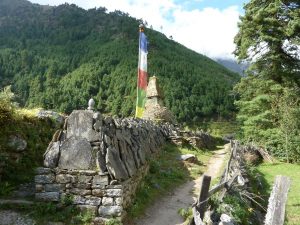
The start of an incredible trekking experience
How difficult is Everest Base Camp trek? And how different is it from Kilimanjaro?
It is difficult to compare the trek to Everest Base Camp to the climb of Kilimanjaro. There are many different ways to climb Kilimanjaro. Some routes are shorter and gain altitude quickly and hence offer little chance for the body to get acclimatised naturally. The shorter routes on Kilimanjaro have a much lower success rate than the trek to Everest Base Camp.
The trek to to Everest Base Camp winds through many different Sherpa settlements and traverses a huge variety of terrain. This adds a huge amount of diversity, colour and vibrancy to the trek. The Khumbu valley also hosts some of the highest mountains in the world which provide an incredible trekking experience.
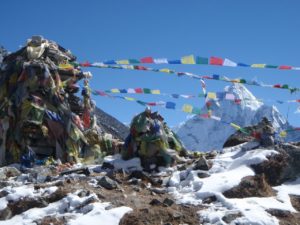 Prayer flags: direction Kala Patthar
Prayer flags: direction Kala Patthar
There are however comparisons to be drawn between the longer routes on Kilimanjaro and the trek to EBC.
On both the average trekking time per day is around 5 to 6 hours and both offer gradual acclimatisation and hence higher success rates.
Overall the trek to EBC is what it says on the tin; a trek to one of the most talked about destinations there is in the world of adventure. On the Everest Base Camp trek you also will find yourself stopping every few hours in a teahouse (an old Sherpa home that has been generously turned into a resting point for trekkers). Here you will either bask in the sunshine and rest in the large communal room that hosts a pot bellied stove so to warm up, giving you time to relax and soak in the vista with a hearty snack and many cups of lemon tea!
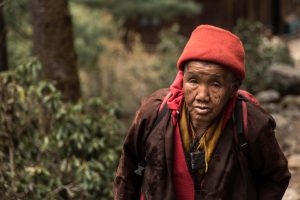 One of the many locals you will meet on the way
One of the many locals you will meet on the way
On the trek to EBC you don’t have a monster summit day of 12-14 hours like you do on Kilimanjaro. The final day’s trek to EBC is a 5 hour stunning walk that’s not all about height gain.
In the mountains, people generally talk in hours rather than kilometres or miles. It can be painful to hear that you have walked for 8 hours but only covered 4 miles!
But for those who need the stats the total distance you walk from Lukla (the village where you fly to from Kathmandu) to Everest base camp is; 38.58 miles or 62 Kilometers.
Generally, teams spend 8 to 9 days to walk up and a 3 to 4 day to walk out.
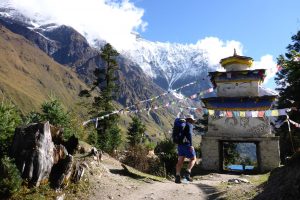 One of the many Buddhist stupa gates found en route
One of the many Buddhist stupa gates found en route
How high is the Everest Base Camp trek?
The starting point is at 2,700 meters and EBC is at 5,400 to 5,500 meters. The highest point reached during the trek is the small (in comparison!) mountain of Kala Pattar which is around 5,550 meters, from here you can see the Khumbu and the Mount Everest in all its magnificence!
The trek in takes longer to climb as it is vital for your body to acclimatize to the increasingly thin air. Our itinerary has been especially designed by the guides and Sherpas for teams attempting to reach the summit of Mount Everest itself.
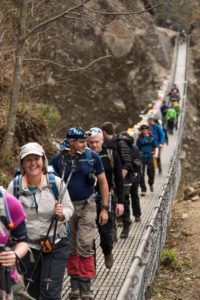 The fun route to Everest Base Camp
The fun route to Everest Base Camp
The trek has plenty of rest days which allow you to explore more of the less trodden parts of the Khumbu valley and to savour it at its fullest. If this approach works for the summit teams then you can be sure it will work for you!
There are generally 2 approaches to Everest Base Camp. The longer and steeper one goes via the Gokyo lakes. The classic approach as done by most teams aiming to summit Mount Everest is not as arduous and to my mind just as beautiful.
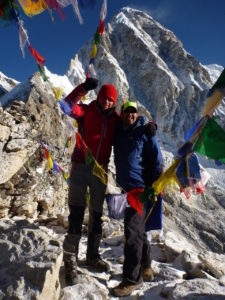
Having a guide can enrichen your experience
What are the best times to trek to Everest Base Camp?
The two main trekking seasons are spring and autumn.
In spring you will find yourself trekking to base camp alongside many climbing teams attempting to climb the mountain itself.
You might get a better insight into what it is like to do this trek from a mountaineer’s point of view and you’ll see the base camp of Everest at its most vibrant as hundreds of tents are pitched along the glacier creating a colourful carnival scene amongst the harshness of the mountains.
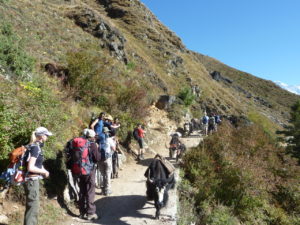 Trekking up Khumbu valley, sharing the route with yaks
Trekking up Khumbu valley, sharing the route with yaks
Spring Season: From Early March to Late May.
Expect warm and sunny days. There may be the occasionally rainy period or snowstorm as you gain altitude but most days will be dry with clear views.
A highlight for this season is that for the first few days you trek through blossoming rhododendron forest adding enormous colour to the trip.
Autumn Season: From September to Early November
Generally cooler and clearer offering trekkers with cloud-less views of snow-capped mountains.
Even though it is not the warmest still expect lot of visitors during this time. Mountaineers rarely attempt the mountain during this period as above base camp the temperature and weather conditions are extremely cold and windy.
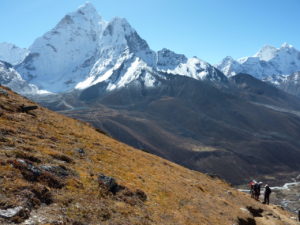 Jaw-dropping scenery whilst on trek
Jaw-dropping scenery whilst on trek
What kit is needed for Everest Base Camp?
Pack for every season. Kathmandu and the first few days of the trek will feel like the UK on a very hot summers day and base camp like a very cold winter day (of course all weather dependent).
The most important item on your kit-list should be your boots. Because of the variety of terrain covered they will need to be strong, flexible, warm and offer good ankle support.
Generally, 3 season trekking boots fit the bill well (they don’t need to be crampon compatible). If you are happy with your boots walking the Scottish Munros then take them to Nepal.
(360 Expeditions will provide you with a comprehensive kit-list which covers all the bases but still lets you travel as lightly as possible.)
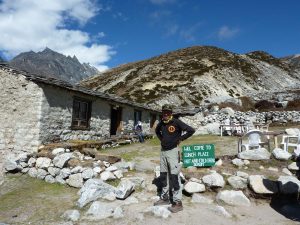 Typical Nepali tea house
Typical Nepali tea houseThis can be done and is a very admirable achievement but includes a lot more time in preparation and organisation which some people find distracts from the overall experience. There are also many pitfalls that need to be avoided and when things go wrong unfortunately it can escalate quickly.
We would always recommend heading out on a guided trek. This not only gives you safety and security but adds so much more to your experience.
It is worth remembering that trekking to Everest Base Camp is not a wilderness experience. Wild-camping is not permitted and since you frequently pass through villages which are used to seeing westerners most modern facilities are readily available.
Everest Base Camp is about experiencing an incredible part of the world and seeing it at its best without organisational and logistical distractions.
Taking a guide, whether through a local agency or better still going through a reputable company – your route will have been well crafted giving you ample rest days while placing you on a great acclimatisation plan giving you the best chance to not only really enjoy the trek but also to arrive at Base Camp itself.
Experiencing the best of Kathmandu before and after the trek, playing football with monks at a monastery, standing in awe as you watch the valley from a hidden view-point, having a beer with Everest high altitude climbing Sherpa as they prepare to go onto the mountain, warming your hands in-front of a fire in a Sherpa kitchen and entering the mighty Khumbu icefall are all aspects not often experienced by solo trekkers.
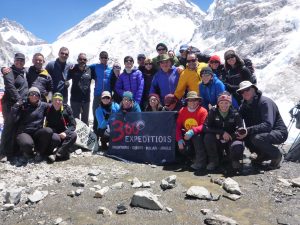 Celebrations at Everest Base Camp
Celebrations at Everest Base CampWhen booking with a UK company they will most likely be sending out a western guide. If travelling with 360 Expeditions then this guide will often be Rolfe who has climbed x4 on the 8000m peaks who brings many fascinating stories to the table with tales of wonders from around the world. Along side Rolfe you will be accompanied by our amazing Sherpas who will add to and enrichen your experience.
We hope you found some of the answers to your Everest Base Camp questions and that you will join us on our next trek in March with Rolfe and Berghaus, who are throwing in many bits of groovy kit.
Book your place now!